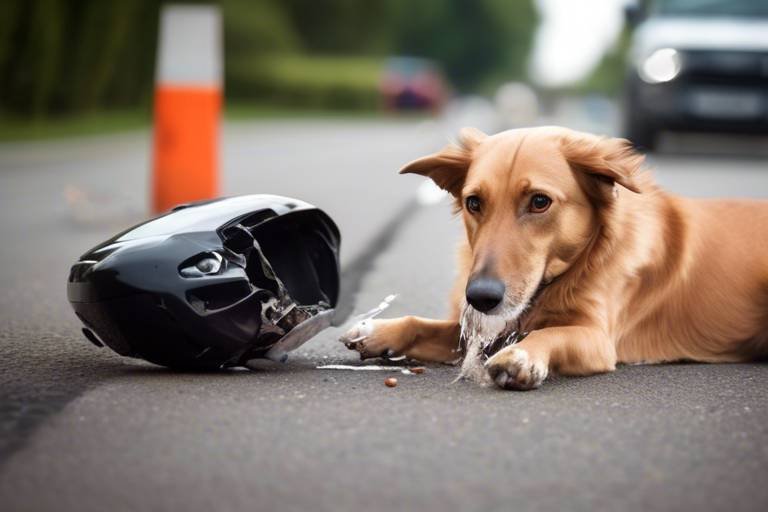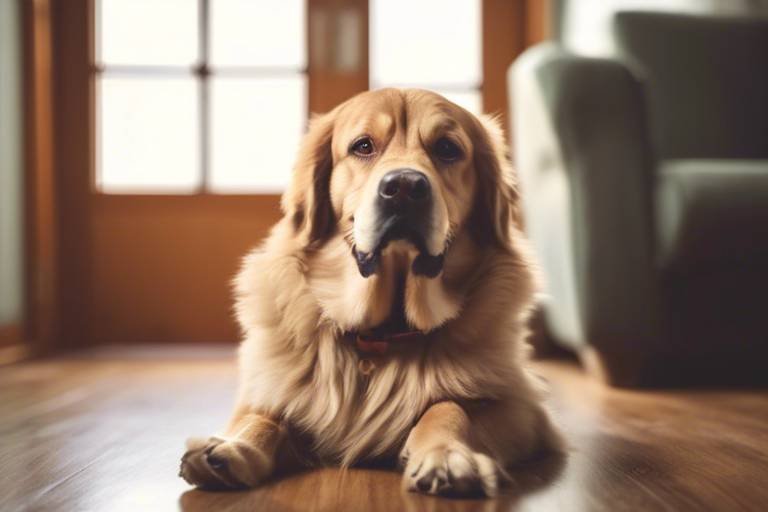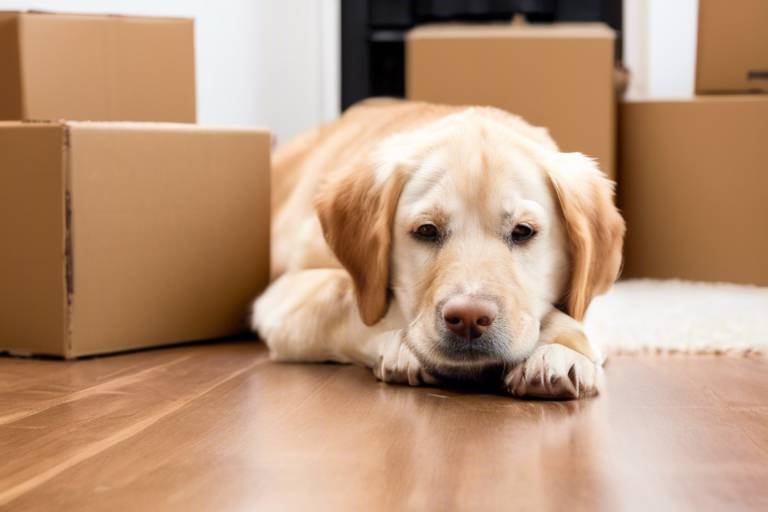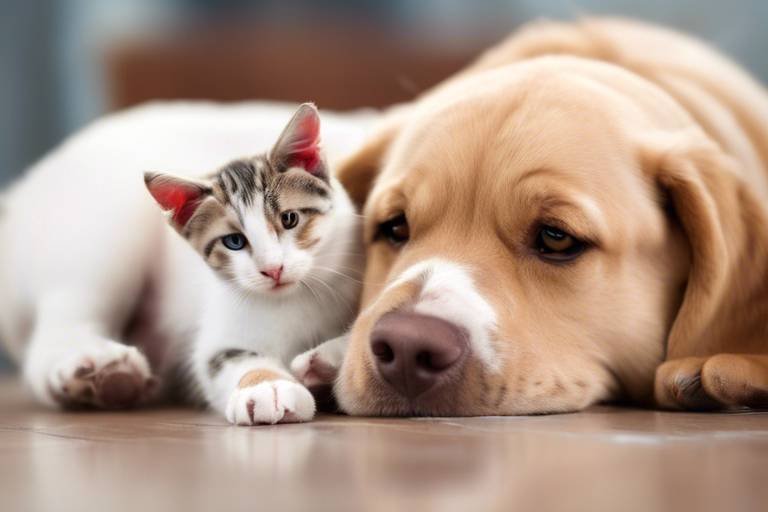How to Handle a Pet That Is Lost or Missing
Finding out that your beloved pet is missing can feel like a punch to the gut. The panic sets in, and your mind races with thoughts of where they could be and how to bring them back home. But take a deep breath—there are effective steps you can take to increase the chances of reuniting with your furry friend. In this article, we’ll guide you through the essential actions to take when your pet goes missing, from immediate responses to utilizing technology and community support. Let’s dive into the heart of the matter and explore how you can turn despair into hope.
As soon as you notice your pet is missing, time is of the essence. The first few hours are crucial, and knowing what to do can significantly enhance your chances of a swift reunion. Start by thoroughly searching your home and yard. Pets often hide in unexpected places, so check under furniture, inside closets, and even in your garage. Don’t forget to call their name—sometimes, a familiar voice can coax them out of hiding.
Next, extend your search to the immediate neighborhood. Walk around the area, calling out their name and looking for any signs of them. Bring along their favorite treats or toys; the sound of a rustling bag or squeaky toy might just bring them out of their hiding spot. It’s also a good idea to talk to your neighbors and ask if they’ve seen your pet. You’d be surprised how helpful a friendly face can be in your search.
Once you’ve conducted a thorough search, it’s time to spread the word. Designing and distributing lost pet flyers can be a game-changer in your quest to find your furry companion. When creating your flyer, include key elements such as:
- A clear photo of your pet that captures their likeness.
- A detailed description including breed, size, color, and any distinguishing features.
- Your contact information so that anyone who finds your pet can reach you quickly.
- Reward information if you’re offering one, as this can motivate people to help.
Make sure your flyers are easy to read and visually appealing. Use bold fonts and bright colors to grab attention. Distributing these flyers in your community can greatly increase the chances of someone spotting your pet and reaching out.
Identifying strategic locations to post your flyers is crucial. Consider placing them in areas where people frequently pass by, such as:
- Local parks
- Grocery stores
- Coffee shops
- Community centers
- Veterinary clinics
The more eyes on your flyer, the better! Also, don’t hesitate to ask local businesses if you can leave a flyer at their counter or bulletin board. Many are happy to help out.
In today’s digital age, leveraging social media platforms can expand your reach exponentially. Share a post on your personal accounts, and don’t forget to include a clear photo and description of your pet. Use relevant hashtags like #LostPet and #HelpFindMyPet to increase visibility. Also, consider joining local community groups on platforms like Facebook, where members are often eager to help.
Community support is vital when searching for a lost pet. Reach out to local animal shelters, rescue organizations, and neighborhood watch groups. Many of these organizations have resources and networks that can assist in your search. Connecting with these groups not only provides additional support but also increases the chances of someone spotting your pet.
Regularly visiting local animal shelters and veterinary clinics can lead to quick reunions. Make a list of nearby shelters and clinics, and visit them in person. Bring along a flyer and ask if they have seen your pet. It’s also helpful to leave a flyer with them in case someone brings your pet in. Remember, shelters often have a high turnover rate, so check back frequently.
Modern technology offers various tools to aid in the search for lost pets. There are numerous apps available that allow you to post about your lost pet, and many of them connect with local shelters and community members. Additionally, some neighborhoods have dedicated websites for lost and found pets, making it easier to spread the word.
Microchips and GPS tracking devices are essential for pet safety. If your pet is microchipped, make sure your contact information is up to date in the chip registry. GPS tracking devices can help you locate your pet quickly if they wander off. These tools are invaluable for preventing loss in the first place and for reuniting you with your pet should they go missing.
There are numerous online platforms dedicated to lost and found pets. Websites like LostMyDoggie.com and PetAmberAlert.com allow you to post about your lost pet, reaching a wider audience. Make sure to provide as much information as possible to increase your chances of recovery.
Losing a pet can be emotionally devastating. It’s essential to take care of your mental health during this challenging time. Talk to friends and family about your feelings, and don’t hesitate to seek support from pet loss support groups, either online or in-person. Remember, it’s okay to grieve; your pet was a cherished part of your life.
Q: What should I do first if my pet goes missing?
A: Start by searching your home and neighborhood thoroughly, calling their name, and checking hiding spots.
Q: How effective are lost pet flyers?
A: Lost pet flyers can be very effective, especially when distributed in high-traffic areas and community hubs.
Q: Can social media really help find my pet?
A: Yes! Social media can significantly increase visibility and connect you with community members who may have seen your pet.
Q: What if I can’t find my pet?
A: Keep looking and don’t give up hope. Utilize technology, community support, and local shelters to continue your search.

Understanding the Immediate Steps
When you realize that your beloved pet is missing, the feeling can be overwhelming—like a punch to the gut. But don’t panic! The first few hours are crucial in the search for your furry friend. You need to spring into action and follow a systematic approach to increase the chances of a reunion. Here’s what you should do immediately:
First and foremost, stay calm. I know, easier said than done, right? But panicking won't help your pet. Take a deep breath and start by checking your home thoroughly. Pets can often hide in the most unexpected places, so look under beds, in closets, or even behind furniture. While you’re searching, call out your pet’s name in a calm, reassuring voice. You’d be surprised how many pets respond to the sound of their owner’s voice, even when they’re scared.
If your initial search doesn’t yield results, it’s time to expand your perimeter. Head outside and look around your neighborhood. Bring along a favorite toy or a treat that your pet loves. The familiar sounds might just lure them back to you. While you’re out, don’t forget to talk to your neighbors. They can be your eyes and ears, so let them know your pet is missing. You can even ask them to keep an eye out for your furry friend.
Another effective step is to create a mental map of the places your pet likes to explore. Pets often stick to familiar routes, so consider checking parks, yards, or even the local pet store. If your pet is particularly adventurous, they might have wandered further than you think.
In the midst of all this, it’s crucial to document your search efforts. Keep a list of places you’ve checked and people you’ve spoken to. This will not only help you stay organized but also ensure you don’t miss any spots. You can even create a timeline of events to track your progress. If you have neighbors who are willing to help, consider forming a small search party. There’s strength in numbers!
Finally, don’t underestimate the power of social media. Posting about your lost pet on platforms like Facebook, Twitter, or Instagram can significantly broaden your search radius. Make sure to include a clear, recent photo of your pet along with a description that highlights any distinguishing features. The more eyes that are on the lookout, the better your chances of finding your furry companion.
In summary, the immediate steps you take after realizing your pet is missing can make all the difference. By staying calm, searching thoroughly, reaching out to your community, and utilizing social media, you can dramatically increase your chances of a joyful reunion with your beloved pet.

Creating Effective Lost Pet Flyers
When your beloved pet goes missing, time is of the essence, and one of the most effective ways to spread the word is through lost pet flyers. These flyers can be a lifeline, connecting you with kind-hearted individuals who might spot your furry friend. But how do you create a flyer that not only grabs attention but also conveys all the necessary information? Let's dive into the essential elements you should include.
First and foremost, your flyer should have a clear and eye-catching headline. Use bold letters to state that your pet is lost. Phrases like "Missing Cat!" or "Help Find My Dog!" should be prominently displayed at the top of the flyer. This way, anyone passing by will immediately know what the flyer is about. Consider using a bright color for the background or border to make it stand out even more.
Next, include a recent, clear photo of your pet. A picture is worth a thousand words, and in this case, it could be worth a reunion! Make sure the photo is high-quality and shows your pet's face clearly. Add a few distinguishing features in the description, such as "fluffy tail" or "white spot on the chest," to help potential finders identify your pet more easily.
Now, let's talk about the details. Your flyer should include:
- Name of your pet: This personal touch can create a connection.
- Breed, size, and color: Be as descriptive as possible.
- Last seen location: Provide a specific area where your pet was last spotted.
- Contact information: Include your phone number and/or email address. Make sure this information is large and easy to read.
Lastly, don't forget to add an incentive. Offering a small reward can motivate people to keep an eye out for your pet. Something simple like “$100 reward for safe return” can make a difference. Just make sure to keep the amount reasonable and within your budget.
Once your flyer is ready, it’s time to distribute it effectively. Think about where pet owners frequent—dog parks, pet stores, and community bulletin boards. The more people who see your flyer, the better your chances of finding your pet. Remember to ask local businesses if you can post your flyer in their windows or on their bulletin boards.
In conclusion, creating effective lost pet flyers is an art that combines clarity, emotional appeal, and strategic distribution. By following these tips, you can maximize your chances of reuniting with your furry friend. Whether it’s a lost dog or a missing cat, every detail counts in the search for your beloved pet.
Choosing the Right Locations
When your beloved pet goes missing, every moment counts, and knowing where to post your flyers can make a world of difference. Imagine your pet wandering in an unfamiliar area, unsure of how to find their way back home. That's why you need to strategically choose high-traffic areas where people frequently pass by. Think about it: the more eyes that see your flyer, the better the chances someone might recognize your furry friend.
Start by considering local parks, as these are popular spots for pet owners and their dogs. If your pet has a habit of wandering off during walks, there's a good chance someone might spot them there. Additionally, busy intersections or community centers are prime locations since they attract a diverse crowd. Remember, the goal is to reach as many people as possible!
Don't forget about local businesses. Stores like pet shops, grocery stores, and coffee shops often have bulletin boards where you can pin your flyers. Not only do these places get a lot of foot traffic, but the people who frequent them are likely to be animal lovers who will keep an eye out for your pet. Consider asking shop owners if they can help spread the word or even share your flyer on their social media pages.
Moreover, community centers and libraries are excellent spots for posting flyers. These places are hubs of activity, where people gather for various events. You might also want to check with local veterinary clinics and animal shelters. They often have a lost-and-found board and can keep an eye out for your pet if someone brings them in.
Here’s a quick rundown of the best locations for posting your lost pet flyers:
- Parks - Great for reaching pet owners.
- Busy intersections - High visibility for passing cars and pedestrians.
- Local businesses - Utilize bulletin boards and community support.
- Community centers - Engage with locals during events.
- Veterinary clinics and shelters - Directly related to pet care and recovery.
Lastly, consider the timing of your flyer distribution. Early mornings and late afternoons are when people are most active, especially dog walkers and commuters. By being proactive and covering the right locations, you significantly increase your chances of reuniting with your lost pet.
Utilizing Social Media
In today's digital age, social media has become a powerful tool for reconnecting with lost pets. When your furry friend goes missing, the first thing you should do is leverage the platforms where people spend most of their time. Think about it: billions of people are scrolling through their feeds every day, and many of them are local to your area. By posting about your lost pet on social media, you can effectively spread the word and increase your chances of a reunion.
Start by creating a compelling post that includes a clear photo of your pet, a detailed description, and your contact information. Make sure to include essential details such as:
- Name of your pet
- Breed and any distinctive features
- Last seen location and date
- Contact information for updates
To maximize your reach, consider posting in local community groups on platforms like Facebook. Many towns and neighborhoods have dedicated groups for lost and found pets, where members actively help each other. Don't hesitate to join these groups and share your post. Additionally, using relevant hashtags can help people who are not in your immediate circle see your plea. For example, hashtags like #LostPet, #HelpFindMyPet, and your local area’s name can make a significant difference.
Another effective strategy is to engage with your followers. Encourage them to share your post, as this can exponentially increase visibility. You might even consider offering a small reward for anyone who helps bring your pet home. This not only motivates people to keep an eye out but also creates a sense of community as everyone rallies together to assist you.
Don't forget about other platforms like Instagram and Twitter. On Instagram, you can use Stories to keep your followers updated on your search, while Twitter allows you to reach a broader audience quickly by tweeting your situation. Remember to tag local animal shelters and organizations in your posts; they often have a large following and can help spread the word even further.
In summary, utilizing social media effectively can turn the tide in your search for a lost pet. By crafting an engaging post, joining local groups, and encouraging community involvement, you can enhance your chances of a happy reunion. So, grab your phone, snap a picture of your beloved pet, and start sharing! You never know who might be the key to bringing your furry friend back home.
Engaging Local Community Groups
When your beloved pet goes missing, it can feel like a nightmare. However, one of the most powerful resources at your disposal is your local community. Engaging with local community groups can significantly increase your chances of finding your furry friend. These groups often have members who are passionate about animal welfare and can mobilize quickly to help in the search.
Start by reaching out to neighborhood associations, pet clubs, and community centers. Many towns have Facebook groups or forums dedicated to lost pets where you can post information and updates. When you share your story, be sure to include a clear description of your pet, any unique identifiers, and a recent photo. The more details you provide, the easier it will be for someone to recognize your pet.
Additionally, consider visiting local parks and recreational areas where pet owners frequently gather. Speak to dog walkers and fellow pet lovers; they can be your eyes and ears in the community. You might even want to print out flyers with your pet's information and ask these individuals to help spread the word. It’s like forming a mini search party, and the more people who are aware, the better!
Don’t forget to connect with local animal shelters and rescue organizations. These groups often have extensive networks and can assist in your search. They might also have lost and found databases where you can post your pet’s information. Here’s a quick table to illustrate the types of local groups you should consider engaging with:
| Type of Group | How They Can Help |
|---|---|
| Neighborhood Associations | Share information with residents, post flyers in community areas. |
| Local Animal Shelters | Check for found pets, post your lost pet on their databases. |
| Pet Clubs | Connect with other pet owners who may have seen your pet. |
| Social Media Groups | Post updates, share photos, and engage with a larger audience. |
By actively engaging with these groups, you not only increase the visibility of your search but also foster a sense of community. Remember, it’s not just about finding your pet; it’s about creating a network of support that can help during this tough time. So don’t hesitate to reach out, share your story, and enlist the help of your neighbors. Together, you can make a difference!
Q: What should I do first if my pet goes missing?
A: Start searching your home and surrounding areas immediately, then notify local shelters and community groups.
Q: How can I create effective lost pet flyers?
A: Include a clear photo, description, your contact information, and any unique identifiers. Distribute them in high-traffic areas.
Q: What if I can't find my pet right away?
A: Keep searching, stay hopeful, and continue to engage with your community. Many pets are found days or even weeks later.
Checking Local Shelters and Vets
When your beloved pet goes missing, one of the most crucial steps you can take is to check local shelters and veterinary clinics regularly. These places often serve as the first stop for anyone who finds a lost animal. Imagine your furry friend wandering, scared and alone, and then being rescued by a kind-hearted stranger who brings them to a nearby shelter. This scenario happens more often than you think, which is why maintaining a consistent presence at these locations can significantly increase your chances of a reunion.
Start by visiting the shelters in your area, but don’t just pop in once and hope for the best. Make it a routine! Go back every few days, as new animals come in frequently. When you visit, be prepared to provide a detailed description of your pet, including:
- Breed: Is your pet a fluffy Golden Retriever or a sleek Siamese cat?
- Color: What are the primary colors of their fur?
- Size: Is your pet small enough to fit in a backpack or large enough to be a gentle giant?
- Distinctive features: Do they have any unique markings, scars, or collars?
Additionally, bring along a recent photo of your pet. A picture is worth a thousand words, and having a visual reference can help shelter staff identify your pet more easily. Don’t hesitate to ask if you can leave a flyer with your pet's information. Many shelters will gladly post it on their bulletin board or share it with their network.
Veterinary clinics are also essential in your search. They often have clients who bring in found pets, and they may keep a record of lost pet reports. Just like with shelters, establish a connection with your local vets. Drop by and introduce yourself, explain your situation, and leave behind flyers. You might be surprised at how many people are willing to help when they see your determination.
Here’s a quick table to help you keep track of the shelters and vets you visit:
| Location | Date Visited | Contact Person | Notes |
|---|---|---|---|
| Local Animal Shelter | MM/DD/YYYY | Name | Any updates or information |
| Veterinary Clinic | MM/DD/YYYY | Name | Any updates or information |
In summary, checking local shelters and veterinary clinics is a vital part of your search for your lost pet. By being proactive, persistent, and organized, you can enhance your chances of bringing your furry friend back home where they belong.

Utilizing Technology in Your Search
In today's digital age, technology plays a pivotal role in helping pet owners locate their missing furry friends. The good news is that there are numerous tools and resources at your fingertips that can make your search more efficient and effective. From mobile apps to tracking devices, leveraging technology can significantly increase your chances of reuniting with your beloved pet.
First and foremost, consider investing in GPS tracking devices. These nifty gadgets can be attached to your pet's collar and allow you to track their location in real time. Imagine having the ability to pinpoint your pet’s whereabouts with just a tap on your smartphone! This not only gives you peace of mind but also enables you to act swiftly if they wander off. Additionally, many of these devices come with features such as activity monitoring and virtual fences that alert you when your pet strays beyond a designated area.
Another essential technology to consider is microchipping. This small chip, implanted under your pet's skin, contains a unique identification number linked to your contact information. Should your pet be found and taken to a vet or shelter, they can scan the chip to quickly identify you as the owner. It's a simple yet effective way to ensure that if your pet goes missing, they can be returned to you without delay. Remember, microchipping is not a replacement for a collar and tag; it's an additional layer of security that can make all the difference.
Furthermore, there are various online lost and found pet databases that can be incredibly helpful. Websites and apps like PawBoost and LostMyPet allow you to post information about your lost pet, complete with photos and descriptions. These platforms connect you with other pet owners and volunteers in your area who can assist in the search. By utilizing these resources, you can cast a wider net and increase the likelihood of someone spotting your pet.
Moreover, social media platforms such as Facebook, Twitter, and Instagram can serve as powerful tools in your search. By sharing posts about your lost pet, you can reach a vast audience in a short amount of time. Consider creating a dedicated post that includes clear photos, a detailed description, and your contact information. You can even join local community groups or pages dedicated to lost pets, where members are often more than willing to help spread the word.
To summarize, technology offers a variety of resources to aid in the search for your lost pet. By utilizing GPS tracking devices, microchips, online databases, and social media, you can enhance your search efforts and improve your chances of a happy reunion. Remember, every moment counts when your pet is missing, so don’t hesitate to tap into these technological advancements!
Here are some common questions pet owners have when utilizing technology in their search for lost pets:
- How effective are GPS tracking devices? GPS tracking devices can be highly effective, especially if your pet is prone to wandering. They provide real-time location updates, which can be crucial in quickly finding your pet.
- Is microchipping painful for my pet? Microchipping is a quick procedure, often compared to a vaccination. Most pets experience minimal discomfort, and the long-term benefits of having a microchip far outweigh the brief moment of discomfort.
- What should I include in my social media post? Be sure to include clear photos, a detailed description of your pet, their last known location, and your contact information to facilitate easy communication.
Tracking Devices and Microchips
When it comes to ensuring the safety of our beloved pets, tracking devices and microchips are game changers. Imagine having a safety net for your furry friend, one that can help reunite you in case they wander off. Microchips are tiny devices, about the size of a grain of rice, implanted under your pet's skin. They contain a unique identification number linked to your contact information. If your pet is found and taken to a vet or shelter, they can easily scan the microchip and contact you. This simple yet effective solution drastically increases the chances of a happy reunion.
On the other hand, tracking devices offer real-time location tracking. These devices are often attached to your pet’s collar and can be monitored through a smartphone app. With GPS technology, you can see exactly where your pet is at any moment. This is especially useful for pets that like to explore or have a tendency to escape. The peace of mind that comes with knowing you can locate your pet instantly is invaluable.
Here’s a quick comparison of the two options:
| Feature | Microchips | Tracking Devices |
|---|---|---|
| Real-time Tracking | No | Yes |
| Implantation Required | Yes | No |
| Battery Life | Permanent | Varies (usually rechargeable) |
| Cost | One-time fee | Initial cost + subscription fee |
While both options have their benefits, using them in tandem can provide the ultimate security for your pet. Think of it as having a belt and suspenders approach. Microchips serve as a permanent backup, while tracking devices offer immediate access to your pet's location. This combination ensures that no matter how far your pet roams, you have the tools to bring them back home safely.
In conclusion, investing in a tracking device and microchip is a proactive step every pet owner should consider. It’s not just about convenience; it’s about ensuring the safety and well-being of your furry family member. Remember, the quicker you act, the better your chances of a joyful reunion. With technology on your side, you can significantly reduce the anxiety that comes with a lost pet.
- How much does it cost to microchip a pet? The cost typically ranges from $25 to $75, depending on the vet and location.
- Are tracking devices safe for pets? Yes, they are designed to be safe and comfortable for pets to wear.
- Can I track my pet if the battery dies? No, tracking devices require a charged battery to function.
- How often should I check my pet's microchip information? It's a good idea to check at least once a year, especially if you move or change phone numbers.
Online Lost and Found Pet Databases
In today’s digital age, the search for your lost pet can be significantly enhanced by utilizing . These platforms serve as virtual bulletin boards, connecting pet owners with potential finders and other concerned community members. By leveraging these resources, you can spread the word about your missing furry friend far and wide, increasing the likelihood of a reunion.
One of the key advantages of using these databases is that they are often frequented by individuals who are actively looking to help lost pets find their way home. Websites such as PawBoost, LostMyPet, and Pet FBI are specifically designed for this purpose. Here’s how you can effectively use these platforms:
- Create a Detailed Profile: When you post about your lost pet, include a detailed description that covers everything from breed, size, and color to any distinctive markings. The more information you provide, the easier it will be for someone to identify your pet.
- Upload Clear Photos: A picture is worth a thousand words. Make sure to upload clear, recent photos of your pet. Ideally, include a few different angles and any unique features that can help in identification.
- Share Contact Information: Always include your contact details so that anyone who thinks they’ve spotted your pet can reach you quickly.
Additionally, many of these databases allow you to set up alerts that notify you when a matching pet is reported found. This feature is incredibly beneficial, as it can help you act quickly if someone finds your pet. Moreover, consider sharing your post on your personal social media accounts to further amplify your reach. The power of community cannot be underestimated, and with just a few clicks, your post can be seen by hundreds, if not thousands, of people.
Finally, remember to keep checking these databases regularly. New posts are made every day, and staying engaged increases your chances of spotting any possible matches. Your lost pet could be just a click away from being found!
Q: How do I know which database to use?
A: It's best to use multiple databases to maximize your reach. Start with the most popular ones like PawBoost, LostMyPet, and Pet FBI, and then check local community groups on social media.
Q: Is there a fee to post on these databases?
A: Most online lost and found pet databases are free to use, but some may offer premium services for additional visibility.
Q: How often should I update my post?
A: Update your post regularly, especially if you have new information or if your pet has been found. Keeping the post fresh can attract more attention.

Emotional Support and Coping Strategies
When you find yourself in the heart-wrenching situation of losing a beloved pet, it's not just the search that weighs heavily on your mind. The emotional turmoil can feel overwhelming, like a storm cloud hanging over your head. It's crucial to recognize that you're not alone in this journey. Many pet owners have faced similar challenges, and there are numerous ways to seek emotional support and develop effective coping strategies.
First and foremost, allow yourself to grieve. It’s completely natural to feel a whirlwind of emotions ranging from sadness to anxiety. Acknowledge these feelings instead of bottling them up. Talk about your pet with friends or family members who understand the bond you shared. Sharing your memories can be incredibly therapeutic. Think of it as a way to keep their spirit alive, like lighting a candle in a dark room.
Consider joining a support group for pet owners who have experienced similar losses. These groups can provide a safe space to express your feelings and share advice. Many communities have local organizations or online forums dedicated to helping pet owners cope with loss. Connecting with others who understand what you’re going through can be a source of comfort and strength.
In addition to seeking support, engaging in activities that bring you joy can help alleviate some of the emotional burden. Whether it’s taking a walk in the park, volunteering at an animal shelter, or even simply spending time with friends, these moments can serve as a welcome distraction. Think of it as watering a plant; it helps you grow and flourish even in tough times.
Moreover, consider creating a tribute to your pet. This could be a scrapbook filled with photos and memories, or even a small memorial in your backyard. Engaging in such activities can provide a sense of closure and allow you to celebrate the life your pet lived. You might be surprised at how cathartic it can be to express your love in this tangible way.
Lastly, don't hesitate to seek professional help if you're feeling particularly lost. Therapists and counselors who specialize in pet loss can offer valuable guidance and coping techniques. They can help you navigate through the emotional maze and find a path toward healing. Remember, it's perfectly okay to ask for help; it’s a sign of strength, not weakness.
- What should I do first if my pet goes missing? Immediately search your home and surrounding area, then notify local shelters and vets.
- How can I cope emotionally with my lost pet? Allow yourself to grieve, seek support from friends or groups, and engage in activities that bring you joy.
- Are there support groups for pet loss? Yes, many communities and online platforms offer support groups specifically for pet owners.
- What if I need more help? Consider speaking to a therapist who specializes in pet loss for professional guidance.
Frequently Asked Questions
-
What should I do first if my pet goes missing?
When you first realize your pet is missing, it’s crucial to stay calm and act quickly. Start by searching your home and yard thoroughly. Call your pet’s name and listen for any sounds. Check hiding spots where they might feel safe. After that, expand your search to the neighborhood, asking neighbors if they’ve seen your furry friend.
-
How can I create effective lost pet flyers?
Your lost pet flyers should be clear and eye-catching. Include a recent photo of your pet, a detailed description, and your contact information. Make sure to add a reward if possible, as this can motivate people to help. Distribute these flyers in high-traffic areas like parks, grocery stores, and community boards to maximize visibility.
-
Is social media useful for finding a lost pet?
Absolutely! Social media can significantly widen your search. Post about your lost pet on platforms like Facebook, Twitter, and Instagram. Use local community groups and hashtags to reach more people. The more eyes on your post, the better your chances of finding your pet!
-
Should I check animal shelters and veterinary clinics?
Yes, regularly visiting local animal shelters and veterinary clinics is essential. Many lost pets are brought to these places. When you visit, bring a flyer and provide them with a detailed description of your pet. It’s a good idea to check back frequently, as new animals come in daily.
-
What technology can help me find my lost pet?
There are several tech tools that can assist in your search. GPS tracking devices can help locate your pet if they wander off. Additionally, microchips are a permanent solution that can help reunite you with your pet if they are found and taken to a vet or shelter.
-
Are there online resources for lost and found pets?
Yes, many websites and apps are dedicated to helping reunite lost pets with their owners. Platforms like Petfinder, LostMyDoggie, and local lost and found pet groups can be invaluable. Make sure to upload clear photos and detailed descriptions to increase your chances of being reunited.
-
How can I cope emotionally while searching for my lost pet?
Losing a pet can be incredibly tough. It’s important to lean on friends and family for support during this stressful time. Consider joining online forums or local support groups where you can share your feelings and get advice from others who have been through similar experiences.



















